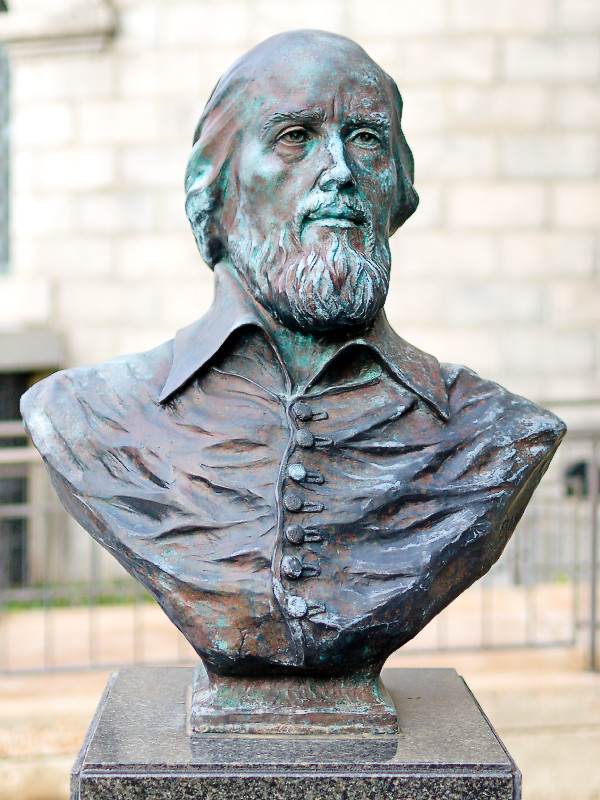“Beauty makes the soul soar and it's as essential to the spirit as food and water is to the body.”
— The Crescat
Monday, January 31, 2011
Canons Regular of the New Jerusalem Establish Home in West Virginia
SEE THE ARTICLE: Canons Regular of the New Jerusalem Establish Home in West Virginia.
The Canons Regular once served in Saint Louis. I have fond memories of their liturgies, which were austere yet noble.
The Canons Regular once served in Saint Louis. I have fond memories of their liturgies, which were austere yet noble.
Saturday, January 29, 2011
"Star of Rome of the West"
A CORRESPONDENT SENT me the following photo:

Archbishop Joseph E. Ritter of the Archdiocese of Saint Louis boards an aircraft named “Star of Rome of the West”, at Lambert Field, on his way to Rome. He returned as Cardinal Ritter.
Photo dates from 1961.

Archbishop Joseph E. Ritter of the Archdiocese of Saint Louis boards an aircraft named “Star of Rome of the West”, at Lambert Field, on his way to Rome. He returned as Cardinal Ritter.
Photo dates from 1961.
Half a Billion
THE GATEWAY ARCH, dating from the mid-1960s, is the great symbol of the City of Saint Louis.
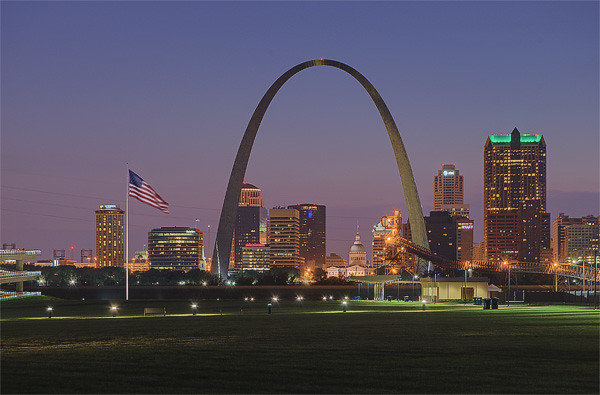
Designed in 1947 by the Finnish-American architect Eero Saarinen (1910-1961), the stainless steel-clad Gateway Arch was selected in 1948 by a jury of prominent architects to be the principal element of the Jefferson National Expansion Memorial, a monument in honor of Thomas Jefferson and the westward expansion of the United States. Construction was from 1963 to 1965, and it opened to the public in 1967.
Like many of the High Modernist architects, Eero Saarinen was classically trained, and we ought not be surprised that he, like many of his contemporaries, was able to produce elegant designs. When the architectural schools dropped the classical ideals, even Modern architecture suffered. I ought to note that Saarinen was until recently one of the most hated of Modern architects; perhaps because he was less of an independent artist with a personal vision, but instead took his clients' needs into great consideration. He lately has had a rehabilitation and his works are now getting more respect among architectural historians.

The Gateway Arch is one of the most-visted tourist attractions in the world, with over three million visitors every year.
 The unrelenting Modernism of the park design, however, means that there isn't too much for the tourist to see or do. The Arch is in a park that is grand in scale yet offers only severe vistas — vast expanses of lawn, two concrete-edged lakes, and pathways lined by trees of one species. A monumental staircase goes to the decayed and (now) mostly unused riverfront below. Like much of Modernism, detail is lacking on a human scale. Many features commonly found in parks, like historical markers, picnic tables, shade pavilions, kiosks selling food and cold beverages, and even public restrooms are missing from this rather plain landscape.
The unrelenting Modernism of the park design, however, means that there isn't too much for the tourist to see or do. The Arch is in a park that is grand in scale yet offers only severe vistas — vast expanses of lawn, two concrete-edged lakes, and pathways lined by trees of one species. A monumental staircase goes to the decayed and (now) mostly unused riverfront below. Like much of Modernism, detail is lacking on a human scale. Many features commonly found in parks, like historical markers, picnic tables, shade pavilions, kiosks selling food and cold beverages, and even public restrooms are missing from this rather plain landscape.
Between the legs of the Arch, concrete steps descend into a visitors' center that includes shops, theaters, and a museum. All visitors must go thorough a security checkpoint. For a fee, you can ride to the top of the Arch, although I wouldn't recommend it if you are either claustrophobic or afraid of heights, but it is otherwise worth the trip up.
[The elevator to the top is a series of capsules, that resemble the interior of a clothes dryer. It is a very tight fit, having been designed back in the days when folks were far less fluffy than they tend to be now. When the capsules ascend, they rotate noticeably, and then abruptly readjust to become vertical again. I had assumed that these were controlled by some sort of mechanical ratchet, but rather there were mercury relays attached to the capsules, and when a certain angle was reached, the relay would fire and an electric motor would readjust the capsule. An old friend of mine re-designed the control system for these capsules, eliminating the relays as well as the abrupt ratcheting effect — it turns out folks missed this, and so he installed a master switch that could turn the ratcheting on or off.]
A map of the area immediately points out a major flaw of the monument:
View Larger Map
The Arch grounds are separated from the rest of downtown Saint Louis by Memorial Drive and Interstate 70. Visitors going between the Arch and Old Courthouse must cross two busy streets and go over the highway on narrow sidewalks.
These two major flaws were addressed in a new design competition, and a revised plan for the Arch was announced this week. See the article Tweaked Arch plan gets price tag: $578 million. The new plan revitalizes the old proposal to cover over Interstate 70 and to remove Memorial Drive, as well as changing the landscaping on the Arch grounds, that will include a new, grand, ground-level entrance to the Arch. A gondola car system is to transport visitors from the Arch to a new visitors' center located across the river: including Illinois in this plan may make funding more forthcoming. The parking garage located on the Arch grounds is to be removed, the riverfront itself is to be renovated, and the road there is to be elevated a bit to lessen its chances of being flooded by the Mississippi River.
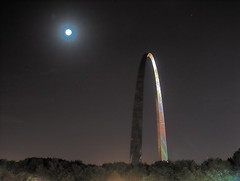 Consider the irony of destroying nearly the entirety of historical downtown Saint Louis in order to create a monument to history. Granted, the area where the Arch now sits was once a dangerous warehouse district, and had a bad reputation at least from the 1870s. The idea of a great memorial there was conceived in 1933 and was approved by U.S. President Franklin Roosevelt in 1935. Destruction commenced in 1939 and was completed in 1942, using power of eminent domain. A few remaining warehouse buildings of this era can be found just north of the Arch at Laclede's Landing. However, this monument was not to be a look back, but rather was forward-looking.
Consider the irony of destroying nearly the entirety of historical downtown Saint Louis in order to create a monument to history. Granted, the area where the Arch now sits was once a dangerous warehouse district, and had a bad reputation at least from the 1870s. The idea of a great memorial there was conceived in 1933 and was approved by U.S. President Franklin Roosevelt in 1935. Destruction commenced in 1939 and was completed in 1942, using power of eminent domain. A few remaining warehouse buildings of this era can be found just north of the Arch at Laclede's Landing. However, this monument was not to be a look back, but rather was forward-looking.
When reviewing the historical documents of the monument's planning, I am struck as to how little any local input was allowed; the men involved in the planning and design were largely all national figures, and the financing of the monument came primarily from the Federal government. Local input came mainly from elected officials and large business owners, such as the Terminal Railroad Association: but even local business interests were largely ignored, since they were clamoring that at least a small part of the land be dedicated to parking, a demand the went unheeded until late in the design process.
The monument competition's jurors unanimously selected Saarinen's proposal and were strong proponents of Modernism; this selection was praised by the New York Times, while local opinions were often extremely negative. Local opinion is now more positive: whatever its flaws, it is ours, and the love of things just because they are familiar is no vice.
 Controversy grew when Saarinen's proposal was discovered to be similar to a design approved by the Italian Fascist dictator Benito Mussolini for a Universal Exposition in Rome. This controversy was dismissed because the concept was abstract enough to have been easily discovered independently, and Saarinen himself considered the controversy to be joke. However, that is a primary danger with abstraction: take for example the simple plain Christian cross, symbolizing any of a large number of varying communities, contradictory creeds, and any form of belief or disbelief; while a Cross with a bloody and battered corpus bearing the Five Wounds and Crown of Thorns can only be, and must be, Catholic, and can only symbolize the Sacrifice and Redemption wrought by Christ. However, it is because of this ambiguity that abstraction and iconoclasm is desired by revolutionaries. Certainly the Modernists wanted to erase the past and shape the future in a new direction.
Controversy grew when Saarinen's proposal was discovered to be similar to a design approved by the Italian Fascist dictator Benito Mussolini for a Universal Exposition in Rome. This controversy was dismissed because the concept was abstract enough to have been easily discovered independently, and Saarinen himself considered the controversy to be joke. However, that is a primary danger with abstraction: take for example the simple plain Christian cross, symbolizing any of a large number of varying communities, contradictory creeds, and any form of belief or disbelief; while a Cross with a bloody and battered corpus bearing the Five Wounds and Crown of Thorns can only be, and must be, Catholic, and can only symbolize the Sacrifice and Redemption wrought by Christ. However, it is because of this ambiguity that abstraction and iconoclasm is desired by revolutionaries. Certainly the Modernists wanted to erase the past and shape the future in a new direction.
Very few historical buildings from the site were preserved. The Old Courthouse, from the very beginning, was intended to become the main historical centerpiece of the monument, and the Gateway Arch was placed specifically along the main axis of the Courthouse to provide a frame for it. The Old Courthouse contains a museum that both portrays the Manifest Destiny of the United States as well as the Dred Scott trial that eventually sparked the American Civil War. The museum under the Gateway Arch opened in the 1970s and is largely unchanged to this day; it primarily focuses on U.S. President Thomas Jefferson, the Lewis and Clark Expedition, the West, and includes environmentalist themes.
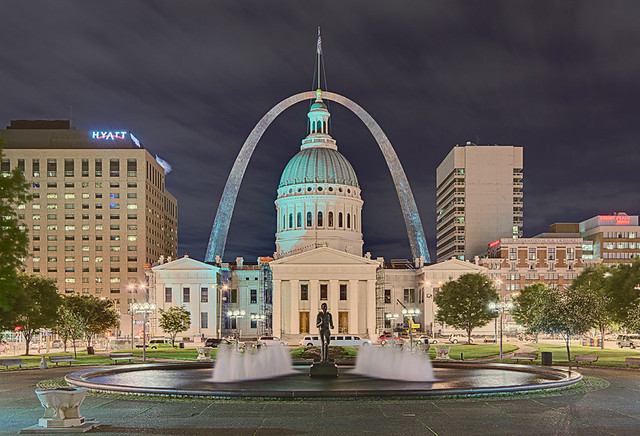
Although large numbers of warehouses were destroyed to make room for the Arch, the architectural ornament from these buildings were preserved and were to be exhibited in a museum that was planned to be located near the site; this never came to fruition, and I am unaware of what happened to this ornament. (Although have a look at the website of the St. Louis Building Arts Foundation).
One building that was preserved, for a while, was fur trader Manuel Lisa's Old Rock House from 1818. It was renovated and turned into a museum, but was destroyed when the Terminal Railroad was relocated into an underground tunnel.
Locals wanted to preserve other buildings, including the Old Customs House and an historic hotel; National Parks officials declined to save these. The Customs House would have been too expensive to restore, while the hotel was too heavily modified from its original condition. They too were destroyed.

While I have much sympathy with historical preservation, one problem is the attitude that disrespects the organic development of a building. Buildings naturally are modified and adapted over the years according to need. Catholics familiar with liturgical reform ought to be quite aware of this process, and the chaos caused by a supposed return to the historical purity of the liturgy — that was actually a revolution. Indeed, it seems that historical preservation and Modernism actually go hand-in-hand and are brothers-in-arms of the Revolution. Consider that many building codes place severe restrictions on historic buildings: in some localities, they must only be restored according to historic standards while using only traditional materials and construction methods, and if they cannot be preserved authentically, then they must inevitably be destroyed. New construction, again according to many building codes, must be of modern design and materials.
Old buildings, at best, are turned into museums. Orthodox architecture may use traditional designs while using the materials and building methods most appropriate for its time. Philosophically, form is more important than matter, and so the design of a building is more important than the materials or construction methods that make it. Contemporary philosophy often tends to confuse form and matter, and places a greater emphasis on matter than form. The Gateway Arch is considered great because it is made of stainless steel, while its form is so simple as to be almost meaningless. Reconstruction of the Old Rock House was abandoned because many of the original stones disintegrated — even though more stones of the same kind could have been easily quarried locally. In both of these cases, lowly matter was considered more important than the greater form of the building.
Urban renewal — the destruction of vast urban areas simply because they are old and usually poor — has destroyed buildings on a scale comparable to 20th century warfare. Although Urban Renewal was a trend most popular in the 1950s and 1960s, the Michigan city of Detroit may soon become the target of this kind of renewal, or rather destruction on a vast scale. This attitude can be found in U.S. Vice President Hubert Humphrey's speech at the inauguration ceremony of the Gateway Arch in 1968: the development of the Arch gave a "new sense of urgency to wipe out every slum". "Whatever is shoddy, whatever is ugly, whatever is waste, whatever is false, will be measured and condemned". Harsh words, but typical. This reminds me of Boethius: wicked men are actually powerless; they are incapable of doing good and can only destroy — and urban renewal in Saint Louis largely had terrible results. There are alternatives.
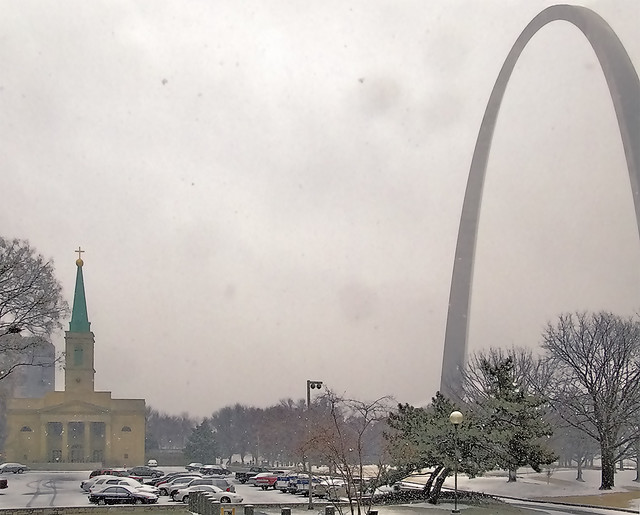
One other building that was preserved is the Basilica of Saint Louis, King of France, or the Old Cathedral, once the Cathedral church for half of the United States. At one time, this was one of the most highly indulgenced churches in the world, gaining all of the privileges of all the major basilicas of Rome. It has very many tourists and is popular for weddings.
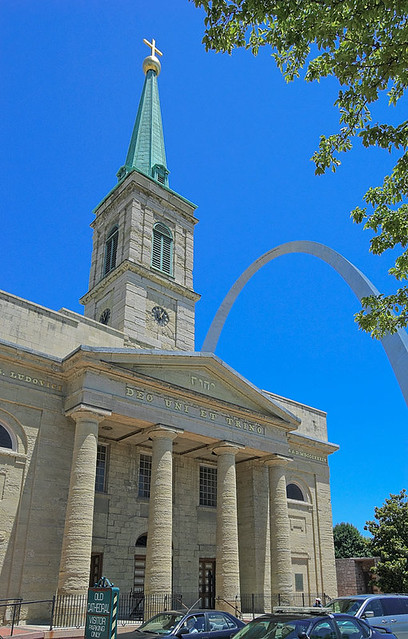
This church is a part of the Archdiocese of Saint Louis and offers daily Mass and Confession. According to the U.S. Department of the Interior, this was to be preserved because it retained most of its original design, although they did destroy the rectory and built a new one more in line with the design of the Arch grounds. It was nice of them to let us keep our church.
The Catholic and Royal history of Saint Louis is barely represented by the monument. It is interesting to compare the Catholic and American histories of this region: the Royal empires typically had modest aims and they knew that nothing was certain; they typically worked hard to have good relations with the native population, who after all, were fellow brethren in Christ. If a Frenchman owned a slave, he prostrated himself in church side-by-side with his slave as equals before God Incarnate, with the Master being far more liable to judgement and eternal damnation. On the contrary, Americans believed that the Grand Architect of the Universe preordained the conquest of the continent, and that Indians and slaves were sub-human, deserving nothing, not even life, if they were not useful. If you can believe it, contemporary American theories are even worse.
While I like seeing both old buildings restored to their original condition and bright shiny new buildings, I most prefer keeping things as they basically are, with good maintenance, occasional improvements, and new construction where it is needed. Nothing needs to be done on a large scale. ‘Improvements’ on a vast scale are often ill-conceived, and future generations often will attempt to reverse these, requiring great cost. Everybody wants progress, but we simply disagree on what progress means.

Designed in 1947 by the Finnish-American architect Eero Saarinen (1910-1961), the stainless steel-clad Gateway Arch was selected in 1948 by a jury of prominent architects to be the principal element of the Jefferson National Expansion Memorial, a monument in honor of Thomas Jefferson and the westward expansion of the United States. Construction was from 1963 to 1965, and it opened to the public in 1967.
Like many of the High Modernist architects, Eero Saarinen was classically trained, and we ought not be surprised that he, like many of his contemporaries, was able to produce elegant designs. When the architectural schools dropped the classical ideals, even Modern architecture suffered. I ought to note that Saarinen was until recently one of the most hated of Modern architects; perhaps because he was less of an independent artist with a personal vision, but instead took his clients' needs into great consideration. He lately has had a rehabilitation and his works are now getting more respect among architectural historians.

The Gateway Arch is one of the most-visted tourist attractions in the world, with over three million visitors every year.
 The unrelenting Modernism of the park design, however, means that there isn't too much for the tourist to see or do. The Arch is in a park that is grand in scale yet offers only severe vistas — vast expanses of lawn, two concrete-edged lakes, and pathways lined by trees of one species. A monumental staircase goes to the decayed and (now) mostly unused riverfront below. Like much of Modernism, detail is lacking on a human scale. Many features commonly found in parks, like historical markers, picnic tables, shade pavilions, kiosks selling food and cold beverages, and even public restrooms are missing from this rather plain landscape.
The unrelenting Modernism of the park design, however, means that there isn't too much for the tourist to see or do. The Arch is in a park that is grand in scale yet offers only severe vistas — vast expanses of lawn, two concrete-edged lakes, and pathways lined by trees of one species. A monumental staircase goes to the decayed and (now) mostly unused riverfront below. Like much of Modernism, detail is lacking on a human scale. Many features commonly found in parks, like historical markers, picnic tables, shade pavilions, kiosks selling food and cold beverages, and even public restrooms are missing from this rather plain landscape.Between the legs of the Arch, concrete steps descend into a visitors' center that includes shops, theaters, and a museum. All visitors must go thorough a security checkpoint. For a fee, you can ride to the top of the Arch, although I wouldn't recommend it if you are either claustrophobic or afraid of heights, but it is otherwise worth the trip up.
[The elevator to the top is a series of capsules, that resemble the interior of a clothes dryer. It is a very tight fit, having been designed back in the days when folks were far less fluffy than they tend to be now. When the capsules ascend, they rotate noticeably, and then abruptly readjust to become vertical again. I had assumed that these were controlled by some sort of mechanical ratchet, but rather there were mercury relays attached to the capsules, and when a certain angle was reached, the relay would fire and an electric motor would readjust the capsule. An old friend of mine re-designed the control system for these capsules, eliminating the relays as well as the abrupt ratcheting effect — it turns out folks missed this, and so he installed a master switch that could turn the ratcheting on or off.]
A map of the area immediately points out a major flaw of the monument:
View Larger Map
The Arch grounds are separated from the rest of downtown Saint Louis by Memorial Drive and Interstate 70. Visitors going between the Arch and Old Courthouse must cross two busy streets and go over the highway on narrow sidewalks.
These two major flaws were addressed in a new design competition, and a revised plan for the Arch was announced this week. See the article Tweaked Arch plan gets price tag: $578 million. The new plan revitalizes the old proposal to cover over Interstate 70 and to remove Memorial Drive, as well as changing the landscaping on the Arch grounds, that will include a new, grand, ground-level entrance to the Arch. A gondola car system is to transport visitors from the Arch to a new visitors' center located across the river: including Illinois in this plan may make funding more forthcoming. The parking garage located on the Arch grounds is to be removed, the riverfront itself is to be renovated, and the road there is to be elevated a bit to lessen its chances of being flooded by the Mississippi River.
 Consider the irony of destroying nearly the entirety of historical downtown Saint Louis in order to create a monument to history. Granted, the area where the Arch now sits was once a dangerous warehouse district, and had a bad reputation at least from the 1870s. The idea of a great memorial there was conceived in 1933 and was approved by U.S. President Franklin Roosevelt in 1935. Destruction commenced in 1939 and was completed in 1942, using power of eminent domain. A few remaining warehouse buildings of this era can be found just north of the Arch at Laclede's Landing. However, this monument was not to be a look back, but rather was forward-looking.
Consider the irony of destroying nearly the entirety of historical downtown Saint Louis in order to create a monument to history. Granted, the area where the Arch now sits was once a dangerous warehouse district, and had a bad reputation at least from the 1870s. The idea of a great memorial there was conceived in 1933 and was approved by U.S. President Franklin Roosevelt in 1935. Destruction commenced in 1939 and was completed in 1942, using power of eminent domain. A few remaining warehouse buildings of this era can be found just north of the Arch at Laclede's Landing. However, this monument was not to be a look back, but rather was forward-looking.When reviewing the historical documents of the monument's planning, I am struck as to how little any local input was allowed; the men involved in the planning and design were largely all national figures, and the financing of the monument came primarily from the Federal government. Local input came mainly from elected officials and large business owners, such as the Terminal Railroad Association: but even local business interests were largely ignored, since they were clamoring that at least a small part of the land be dedicated to parking, a demand the went unheeded until late in the design process.
The monument competition's jurors unanimously selected Saarinen's proposal and were strong proponents of Modernism; this selection was praised by the New York Times, while local opinions were often extremely negative. Local opinion is now more positive: whatever its flaws, it is ours, and the love of things just because they are familiar is no vice.
 Controversy grew when Saarinen's proposal was discovered to be similar to a design approved by the Italian Fascist dictator Benito Mussolini for a Universal Exposition in Rome. This controversy was dismissed because the concept was abstract enough to have been easily discovered independently, and Saarinen himself considered the controversy to be joke. However, that is a primary danger with abstraction: take for example the simple plain Christian cross, symbolizing any of a large number of varying communities, contradictory creeds, and any form of belief or disbelief; while a Cross with a bloody and battered corpus bearing the Five Wounds and Crown of Thorns can only be, and must be, Catholic, and can only symbolize the Sacrifice and Redemption wrought by Christ. However, it is because of this ambiguity that abstraction and iconoclasm is desired by revolutionaries. Certainly the Modernists wanted to erase the past and shape the future in a new direction.
Controversy grew when Saarinen's proposal was discovered to be similar to a design approved by the Italian Fascist dictator Benito Mussolini for a Universal Exposition in Rome. This controversy was dismissed because the concept was abstract enough to have been easily discovered independently, and Saarinen himself considered the controversy to be joke. However, that is a primary danger with abstraction: take for example the simple plain Christian cross, symbolizing any of a large number of varying communities, contradictory creeds, and any form of belief or disbelief; while a Cross with a bloody and battered corpus bearing the Five Wounds and Crown of Thorns can only be, and must be, Catholic, and can only symbolize the Sacrifice and Redemption wrought by Christ. However, it is because of this ambiguity that abstraction and iconoclasm is desired by revolutionaries. Certainly the Modernists wanted to erase the past and shape the future in a new direction.Very few historical buildings from the site were preserved. The Old Courthouse, from the very beginning, was intended to become the main historical centerpiece of the monument, and the Gateway Arch was placed specifically along the main axis of the Courthouse to provide a frame for it. The Old Courthouse contains a museum that both portrays the Manifest Destiny of the United States as well as the Dred Scott trial that eventually sparked the American Civil War. The museum under the Gateway Arch opened in the 1970s and is largely unchanged to this day; it primarily focuses on U.S. President Thomas Jefferson, the Lewis and Clark Expedition, the West, and includes environmentalist themes.

Although large numbers of warehouses were destroyed to make room for the Arch, the architectural ornament from these buildings were preserved and were to be exhibited in a museum that was planned to be located near the site; this never came to fruition, and I am unaware of what happened to this ornament. (Although have a look at the website of the St. Louis Building Arts Foundation).
One building that was preserved, for a while, was fur trader Manuel Lisa's Old Rock House from 1818. It was renovated and turned into a museum, but was destroyed when the Terminal Railroad was relocated into an underground tunnel.
Locals wanted to preserve other buildings, including the Old Customs House and an historic hotel; National Parks officials declined to save these. The Customs House would have been too expensive to restore, while the hotel was too heavily modified from its original condition. They too were destroyed.

While I have much sympathy with historical preservation, one problem is the attitude that disrespects the organic development of a building. Buildings naturally are modified and adapted over the years according to need. Catholics familiar with liturgical reform ought to be quite aware of this process, and the chaos caused by a supposed return to the historical purity of the liturgy — that was actually a revolution. Indeed, it seems that historical preservation and Modernism actually go hand-in-hand and are brothers-in-arms of the Revolution. Consider that many building codes place severe restrictions on historic buildings: in some localities, they must only be restored according to historic standards while using only traditional materials and construction methods, and if they cannot be preserved authentically, then they must inevitably be destroyed. New construction, again according to many building codes, must be of modern design and materials.
Old buildings, at best, are turned into museums. Orthodox architecture may use traditional designs while using the materials and building methods most appropriate for its time. Philosophically, form is more important than matter, and so the design of a building is more important than the materials or construction methods that make it. Contemporary philosophy often tends to confuse form and matter, and places a greater emphasis on matter than form. The Gateway Arch is considered great because it is made of stainless steel, while its form is so simple as to be almost meaningless. Reconstruction of the Old Rock House was abandoned because many of the original stones disintegrated — even though more stones of the same kind could have been easily quarried locally. In both of these cases, lowly matter was considered more important than the greater form of the building.
Urban renewal — the destruction of vast urban areas simply because they are old and usually poor — has destroyed buildings on a scale comparable to 20th century warfare. Although Urban Renewal was a trend most popular in the 1950s and 1960s, the Michigan city of Detroit may soon become the target of this kind of renewal, or rather destruction on a vast scale. This attitude can be found in U.S. Vice President Hubert Humphrey's speech at the inauguration ceremony of the Gateway Arch in 1968: the development of the Arch gave a "new sense of urgency to wipe out every slum". "Whatever is shoddy, whatever is ugly, whatever is waste, whatever is false, will be measured and condemned". Harsh words, but typical. This reminds me of Boethius: wicked men are actually powerless; they are incapable of doing good and can only destroy — and urban renewal in Saint Louis largely had terrible results. There are alternatives.

One other building that was preserved is the Basilica of Saint Louis, King of France, or the Old Cathedral, once the Cathedral church for half of the United States. At one time, this was one of the most highly indulgenced churches in the world, gaining all of the privileges of all the major basilicas of Rome. It has very many tourists and is popular for weddings.

This church is a part of the Archdiocese of Saint Louis and offers daily Mass and Confession. According to the U.S. Department of the Interior, this was to be preserved because it retained most of its original design, although they did destroy the rectory and built a new one more in line with the design of the Arch grounds. It was nice of them to let us keep our church.
The Catholic and Royal history of Saint Louis is barely represented by the monument. It is interesting to compare the Catholic and American histories of this region: the Royal empires typically had modest aims and they knew that nothing was certain; they typically worked hard to have good relations with the native population, who after all, were fellow brethren in Christ. If a Frenchman owned a slave, he prostrated himself in church side-by-side with his slave as equals before God Incarnate, with the Master being far more liable to judgement and eternal damnation. On the contrary, Americans believed that the Grand Architect of the Universe preordained the conquest of the continent, and that Indians and slaves were sub-human, deserving nothing, not even life, if they were not useful. If you can believe it, contemporary American theories are even worse.
While I like seeing both old buildings restored to their original condition and bright shiny new buildings, I most prefer keeping things as they basically are, with good maintenance, occasional improvements, and new construction where it is needed. Nothing needs to be done on a large scale. ‘Improvements’ on a vast scale are often ill-conceived, and future generations often will attempt to reverse these, requiring great cost. Everybody wants progress, but we simply disagree on what progress means.

Labels:
architecture,
history,
news,
opinion,
photos
Thursday, January 27, 2011
Top Catholic Blogs
A LIST OF top Catholic blogs: http://ericsammons.com/topcatholicblogs.html
Monday, January 24, 2011
Photos of Saint Joseph Church, in Highland, Missouri
HERE ARE PHOTOS of Saint Joseph Church, in the village of Highland, Missouri. The church is located about 87 highway miles southeast of downtown Saint Louis, in Perry County.
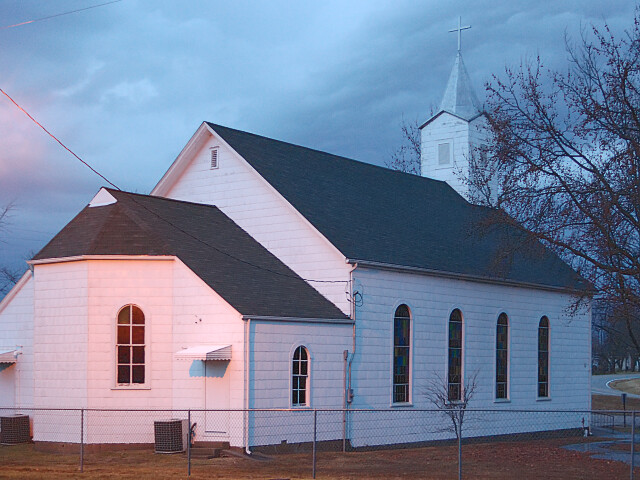
A large monument in front of the church tells of its history: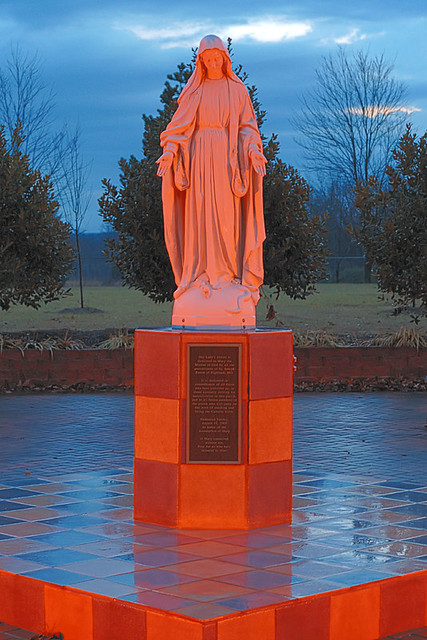
A shrine to Our Lady is behind the church. The plaque reads:

A large monument in front of the church tells of its history:
One in the Lord
St. Joseph Parish
OUR HERITAGE
June 11, 1910
-- Fr. Martin Mary Gregory, C.M. was the Founder
-- The land for the Church and Hall was donated by Simon J. Lukefahr, Sr. and wife Frances.
-- The wood for construction was given by Frank Emmendorfer.
-- The Church was built by men of the parish --
especially Henry Schumer, Vince Bey & Wendelin Behile.
-- The organ was donated by the Children of Mary.
-- The Stations of the Cross were given by the Blessed Sacrament Sodality.
Our Parish Hall
Mid 1920's -- The Parish Hall was built under the direction of Fr. John Taugher, C.M.
Our Parish Church and Cemetery
The Church and Cemetery grounds are composed of three parcels of land. Land for the Church & Church Hall was donated by Simon J. Lukefahr, Sr. and wife Frances on June 11, 1910. The first parcel was given to the parish, but deeded to St. Mary's Seminary. A second parcel for the parish Cemetery was donated by William Meister and wife Agnes on Dec. 3, 1910. Finally, a third parcel was given to the parish in the name of St. Mary's Seminary by Clarence J. Lukefahr and wife Martha on July 23, 1941.
St. Mary's Seminary sold the land for the Church and Hall and the third parcel to the Archdiocese of St. Louis on May 10, 1965. The remaining parcel for the Cemetery was sold by the Seminary to the Archdiocese on May 25, 1965.
Our prayer is “that the One who began the good work in you [us] will continue to complete it until the day of Christ Jesus” Philippians 1:6
Donated by Gary J. and Delores M. Welker

A shrine to Our Lady is behind the church. The plaque reads:
Our Lady's Shrine isClick here for map to parish.
dedicated to Mary the
Mother of God by all the
parishioners of St. Joseph
Parish of Highland, MO.
It is dedicated in
remembrance of all those
who have preceded us, to
those currently striving for
sanctification in this parish,
and to all future members of
the parish who will carry on
the work of teaching and
living the Catholic Faith.
Dedicated Sunday,
August 14, 2005
In honor of the
Assumption of Mary
O Mary conceived
without sin,
Pray for us who have
recourse to thee!
Friday, January 21, 2011
A Snowy Night in Saint Louis
SNOW IS NOT uncommon in Saint Louis winters, but significant amounts of snowfall — more than a few inches — is rare enough to justify taking a few pictures, especially while it is still fresh.

Here are photos I took a couple of nights ago. Remarkably, street lighting reflecting off the snow made these scenes bright, and I didn't need to use a tripod to take these photos. I did not correct for the color of the lighting here, giving these an unusual orange shade.
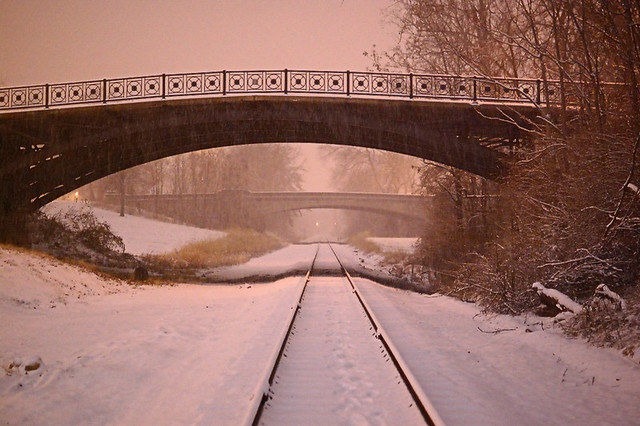
Railroad track, in Carondelet Park.

Decorative gate, at Lafayette Park.
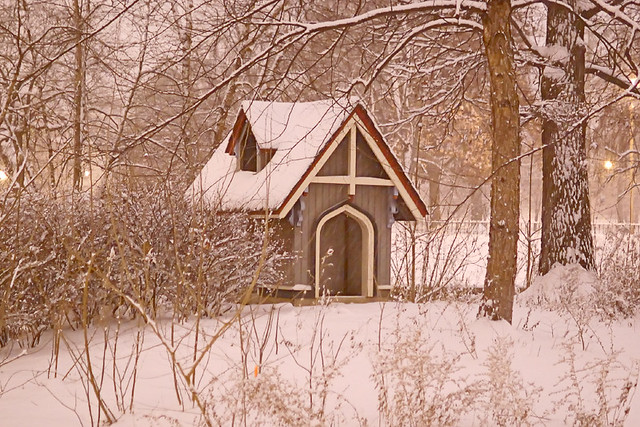
Swan house in Lafayette Park. Some white swans reside here, and I saw them in the adjacent pond.

Wrought-iron bridge.
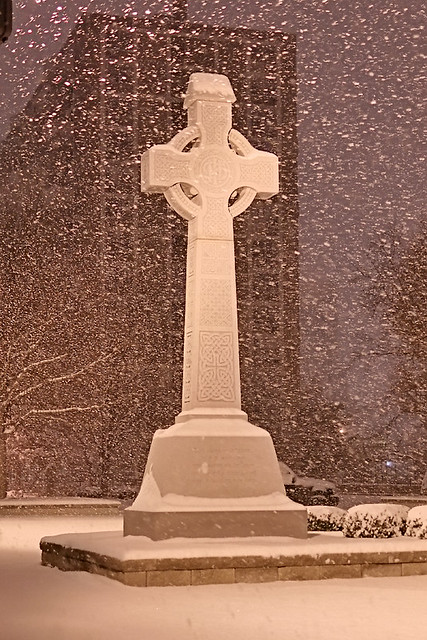
Celtic cross, in front of Saint John the Apostle and Evangelist Church, downtown.

Heroic allegorical figure, at the Soldiers Memorial.

Decorative eagle, also at the memorial.
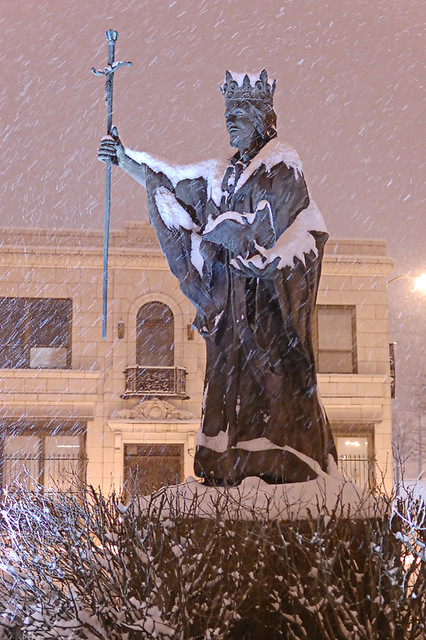
Statue of Saint Louis IX, King of France, at Saint Louis University.
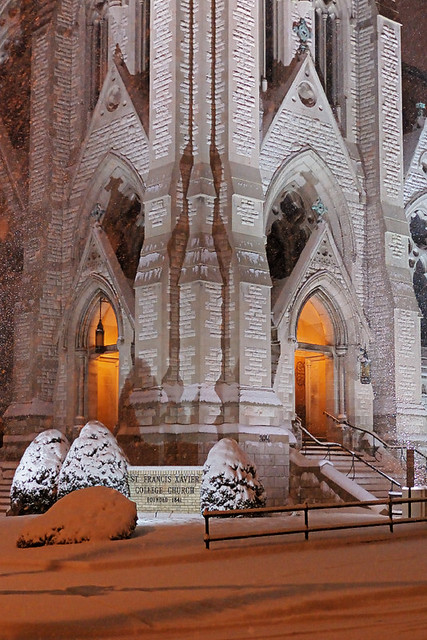
Saint Francis Xavier Church.

Maryland Plaza.

Cafe tables.
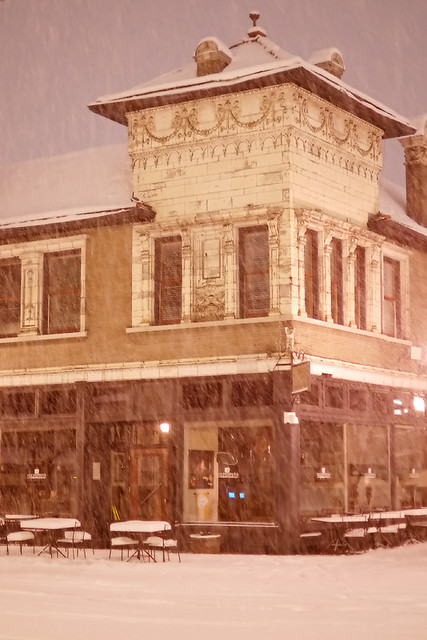
Also at Maryland Plaza.
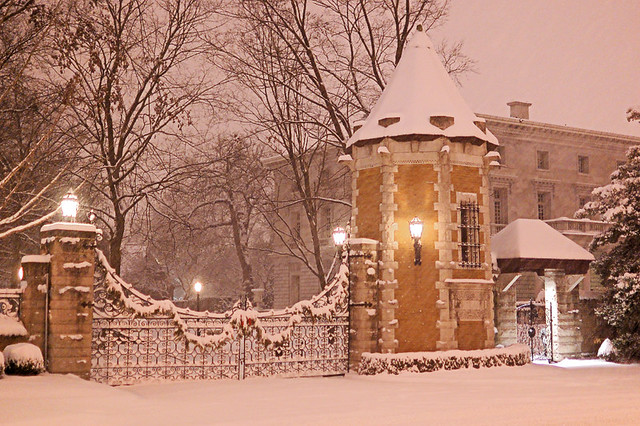
Gated street, off of Kingshighway.

Another gate.
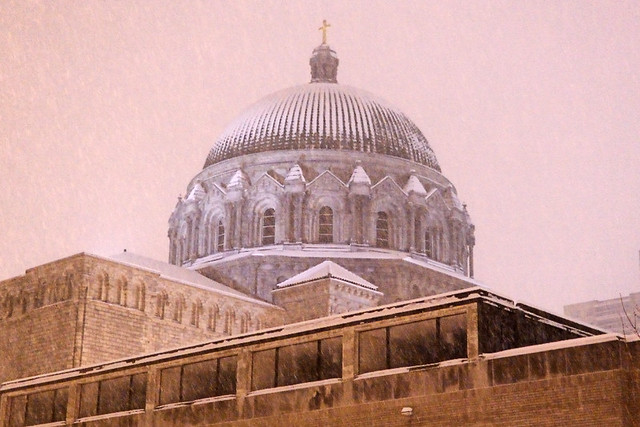
The Cathedral Basilica of Saint Louis.

Another sculpture of Saint Louis. This resides in front of the Art Museum, atop Art Hill.

Art Hill is excellent for snow sledding. Here sledders warm themselves by one of the bonfires.

A suspension bridge, with the Art Museum in the background.

Here are photos I took a couple of nights ago. Remarkably, street lighting reflecting off the snow made these scenes bright, and I didn't need to use a tripod to take these photos. I did not correct for the color of the lighting here, giving these an unusual orange shade.

Railroad track, in Carondelet Park.

Decorative gate, at Lafayette Park.

Swan house in Lafayette Park. Some white swans reside here, and I saw them in the adjacent pond.

Wrought-iron bridge.

Celtic cross, in front of Saint John the Apostle and Evangelist Church, downtown.

Heroic allegorical figure, at the Soldiers Memorial.

Decorative eagle, also at the memorial.

Statue of Saint Louis IX, King of France, at Saint Louis University.

Saint Francis Xavier Church.

Maryland Plaza.

Cafe tables.

Also at Maryland Plaza.

Gated street, off of Kingshighway.

Another gate.

The Cathedral Basilica of Saint Louis.

Another sculpture of Saint Louis. This resides in front of the Art Museum, atop Art Hill.

Art Hill is excellent for snow sledding. Here sledders warm themselves by one of the bonfires.

A suspension bridge, with the Art Museum in the background.
On Social Modesty
CONSIDER THESE TWO alternative examples of social modesty:
Every culture recognizes the value of modesty, although how cultures translate modesty into specific rules varies. But consider a person with no value of modesty at all: undoubtably, they would be considered by nearly everyone as being seriously troubled, or worse. Modesty is therefore an objective value, and isn't a case of just whatever.
It is in the nature of sin that people flee from one vice only to embrace the opposite vice without finding true virtue in the middle. Western elite society is undergoing a serious flirtation with Islam (with some secularist women even adopting the veil out of choice) and God only knows where this will lead: how long until police in Paris or London will start flogging women who show too much?
So should the burden of modesty fall on the woman, or on the man? Traditionally, it is equally both, encouraging both modest dress and custody of the eyes. Proper modesty is something everyone participates in: social modesty is something that people ought to do as a part of their normal lives. Modesty is not something that we do because we fear the police, but neither ought we claim the spurious right to act immodestly. Modesty is a social good. Most men would likely prefer their wives to dress modestly in public, and most women likely would prefer that their husbands practice custody of the eyes. A society that values marriage would then value modesty — and likewise, a society that does not value marriage, like our own, will likely not value modesty much.
I would like to live in a modest culture. Now I don't claim to be particularly modest myself. Since I'm easily distracted, sometimes it takes a while for me to catch myself and practice custody of the eyes, or if I must look, then looking dispassionately. But at least I understand that what I am doing may be quite wrong. My passions, although not bad, ought to be governed by my intellect, and I do realize that I have a fallen nature. Many men (myself included) are likely unaware how the simple act of looking can harm their relationships and reputation. Likewise, many women dress immodestly because it is cute, and may not realize the effect it has on others.
Chief among the ‘difficult sayings’ of Our Lord are those which state that mere thoughts can be mortal sins, particularly those against “looking lustfully at a woman” and being angry, which are equivalent to adultery and murder. The world does not understand this, but does not an action start with a thought? Someone who acts wrongly starts by thinking wrongly. Someone who does not toy with violent thoughts will likely not commit violence, and the same goes with adultery. Society ought not encourage these thoughts, but neither should it employ psychologists to tease out “thought crimes”, rather it should start with individuals and their friends and neighbors.
Our society is quite sick in that it promotes immodesty and violence through the media and in our daily lives, while simultaneously promoting a police state, a fearsome judiciary, and the use of psychology as an instrument of social control: this is undoubtably a policy of social darwinism if not even nihilism. The world hates a culture which encourages individual virtue and social self-control, but working towards social modesty is a good start in combatting these evils.
- In rural Afghanistan, women wear full-body coverings that veil everything but the eyes. Modesty is enforced by police.
- On beaches frequented by Western tourists, women often dress as little as possible. Modesty is a matter of individual choice.
Differing opinions on the value of modesty are shown here. These imply:
- In Afghanistan, the burden of modesty is placed on the woman, who has to be certain that nothing in her dress attracts the attention of men.
- In the West, the burden of modesty is placed on the man. The sunbather does not want creepy old men looking at her.
It is in the nature of sin that people flee from one vice only to embrace the opposite vice without finding true virtue in the middle. Western elite society is undergoing a serious flirtation with Islam (with some secularist women even adopting the veil out of choice) and God only knows where this will lead: how long until police in Paris or London will start flogging women who show too much?
So should the burden of modesty fall on the woman, or on the man? Traditionally, it is equally both, encouraging both modest dress and custody of the eyes. Proper modesty is something everyone participates in: social modesty is something that people ought to do as a part of their normal lives. Modesty is not something that we do because we fear the police, but neither ought we claim the spurious right to act immodestly. Modesty is a social good. Most men would likely prefer their wives to dress modestly in public, and most women likely would prefer that their husbands practice custody of the eyes. A society that values marriage would then value modesty — and likewise, a society that does not value marriage, like our own, will likely not value modesty much.
I would like to live in a modest culture. Now I don't claim to be particularly modest myself. Since I'm easily distracted, sometimes it takes a while for me to catch myself and practice custody of the eyes, or if I must look, then looking dispassionately. But at least I understand that what I am doing may be quite wrong. My passions, although not bad, ought to be governed by my intellect, and I do realize that I have a fallen nature. Many men (myself included) are likely unaware how the simple act of looking can harm their relationships and reputation. Likewise, many women dress immodestly because it is cute, and may not realize the effect it has on others.
Chief among the ‘difficult sayings’ of Our Lord are those which state that mere thoughts can be mortal sins, particularly those against “looking lustfully at a woman” and being angry, which are equivalent to adultery and murder. The world does not understand this, but does not an action start with a thought? Someone who acts wrongly starts by thinking wrongly. Someone who does not toy with violent thoughts will likely not commit violence, and the same goes with adultery. Society ought not encourage these thoughts, but neither should it employ psychologists to tease out “thought crimes”, rather it should start with individuals and their friends and neighbors.
Our society is quite sick in that it promotes immodesty and violence through the media and in our daily lives, while simultaneously promoting a police state, a fearsome judiciary, and the use of psychology as an instrument of social control: this is undoubtably a policy of social darwinism if not even nihilism. The world hates a culture which encourages individual virtue and social self-control, but working towards social modesty is a good start in combatting these evils.
Tuesday, January 18, 2011
Common Errors About the Ancient World
A CORRESPONDENT SENT me a link to a fascinating blog of Classical history, maintained by historians Jona Lendering and Bill Thayer, which can be visited here. At this time, the first article is entitled The First Law of Archaeology, which is “if you do not know what it is, it has something to do with religion.” This, of course, is a sarcastic commentary.
Of general interest is a series of articles called Common Errors, which lists misconceptions about the ancient world. Article 33, Cradle of Civilization, notes that pilgrims ought to have a skeptical attitude towards historical sites (but I must add that this does not preclude piety) and specifically realize that buildings have been rebuilt, modified, and redecorated over the millennia.
More damaging is the contemporary intellectual understanding of the ancient past. Inspired by the Enlightenment, most secular universities divide antiquities into two separate departments. If you want to study Greek or Latin, you must study in the Classics department, which typically views its subject from the direction of rationalism and humanism. Woe unto you if you are interested in Ecclesiastical Latin. Likewise, Near Eastern antiquities are assigned to the Semitic languages department, which tend to be interested primarily in religion. This division of knowledge, not found in the Medieval universities, has led to numerous noxious philosophies and a false view of history (such as West = rationalism, East = mysticism).
People have long assumed that classical sculpture, in its finished state, was unpainted. The aesthetic theories developed from the Renaissance thought that this was actually a good thing, and these theories led unfortunately to a rejection of beauty in the arts. But Church art, even from late Antiquity, is generally colored, but this evidence was rejected as a Medieval barbarism (due to the theory that Catholicism = bad). The article White Sculpture states that ancient Greek and Roman buildings and statuary were in fact painted and used stones of many colors.
However, modern recreations of these painted statues appear garish, ugly, and comical. Were I a gambling man, and if I had the funds, I would bet that these in fact were not painted in a simplistic and garish fashion as depicted. The sculpture is so finely done that I would bet that these were painted in an equally fine manner — a garish and bright base coat of paint would be overpainted by other tones, giving great surface modulation and detail, in a way that would look elegant. Just like we find in Medieval statuary and icons, and probably even better. This multiple layering of paint is a common technique found everywhere.
The articles The Gnostic Gospels and The End of the Library of Alexandria dispels the idea that early Christians burned the books of pagans and heretics. Rather, the natural process of decay would ensure that books — if they are not frequently re-copied — would soon disappear. This is the fate of the great Library of Alexandria: some 4000 manuscripts would have to be copied every year to preserve the collection, and this copying is expensive and can hardly be done under the conditions of warfare and the dissolution of society.
We are in a similar situation today. Very many books in our libraries are at risk of being lost; the fact that Google has scanned millions of these books may in fact hasten their destruction — why support multiple physical copies of a book of marginal importance when everyone has electronic access to these online? But please note that the optical character recognition of these scans is often horrendous, and will cause even more headaches for future scholars than hand-copied manuscripts of ages past. Our electronic infrastructure is very fragile and should not be relied on.
Of general interest is a series of articles called Common Errors, which lists misconceptions about the ancient world. Article 33, Cradle of Civilization, notes that pilgrims ought to have a skeptical attitude towards historical sites (but I must add that this does not preclude piety) and specifically realize that buildings have been rebuilt, modified, and redecorated over the millennia.
More damaging is the contemporary intellectual understanding of the ancient past. Inspired by the Enlightenment, most secular universities divide antiquities into two separate departments. If you want to study Greek or Latin, you must study in the Classics department, which typically views its subject from the direction of rationalism and humanism. Woe unto you if you are interested in Ecclesiastical Latin. Likewise, Near Eastern antiquities are assigned to the Semitic languages department, which tend to be interested primarily in religion. This division of knowledge, not found in the Medieval universities, has led to numerous noxious philosophies and a false view of history (such as West = rationalism, East = mysticism).
People have long assumed that classical sculpture, in its finished state, was unpainted. The aesthetic theories developed from the Renaissance thought that this was actually a good thing, and these theories led unfortunately to a rejection of beauty in the arts. But Church art, even from late Antiquity, is generally colored, but this evidence was rejected as a Medieval barbarism (due to the theory that Catholicism = bad). The article White Sculpture states that ancient Greek and Roman buildings and statuary were in fact painted and used stones of many colors.
However, modern recreations of these painted statues appear garish, ugly, and comical. Were I a gambling man, and if I had the funds, I would bet that these in fact were not painted in a simplistic and garish fashion as depicted. The sculpture is so finely done that I would bet that these were painted in an equally fine manner — a garish and bright base coat of paint would be overpainted by other tones, giving great surface modulation and detail, in a way that would look elegant. Just like we find in Medieval statuary and icons, and probably even better. This multiple layering of paint is a common technique found everywhere.
The articles The Gnostic Gospels and The End of the Library of Alexandria dispels the idea that early Christians burned the books of pagans and heretics. Rather, the natural process of decay would ensure that books — if they are not frequently re-copied — would soon disappear. This is the fate of the great Library of Alexandria: some 4000 manuscripts would have to be copied every year to preserve the collection, and this copying is expensive and can hardly be done under the conditions of warfare and the dissolution of society.
We are in a similar situation today. Very many books in our libraries are at risk of being lost; the fact that Google has scanned millions of these books may in fact hasten their destruction — why support multiple physical copies of a book of marginal importance when everyone has electronic access to these online? But please note that the optical character recognition of these scans is often horrendous, and will cause even more headaches for future scholars than hand-copied manuscripts of ages past. Our electronic infrastructure is very fragile and should not be relied on.
Sunday, January 16, 2011
Photos of Saint Maurus Church, in Biehle, Missouri
HERE ARE PHOTOS of Saint Maurus Church, in Biehle, Missouri. Located in southern Perry County, this church is about 88 highway miles southeast of downtown Saint Louis, in the southernmost part of the Archdiocese.
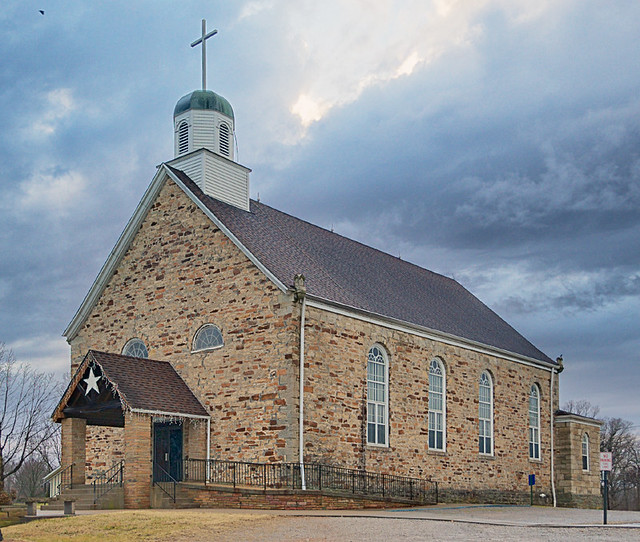
A brief history of this church, according to the Mississippi Valley Architecture website:

Photo taken on December 31st, 2010, during the Octave of Christmas; the church interior has been redecorated in recent years. A closer view of the crèche is here.
According to the 2010 Status Animarum, this parish serves 308 Catholics.
According to one history, Biehle is
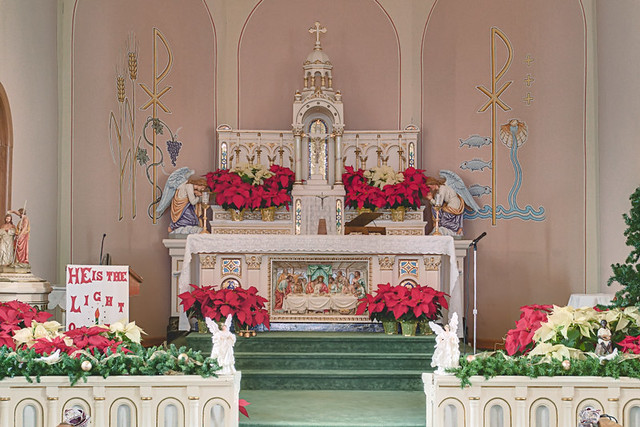
Festive Christmas decorations. This parish shares its pastor with nearby Saint Joseph in Apple Creek; Mass in Latin is offered here on some Saturdays: check the parish bulletin for details.
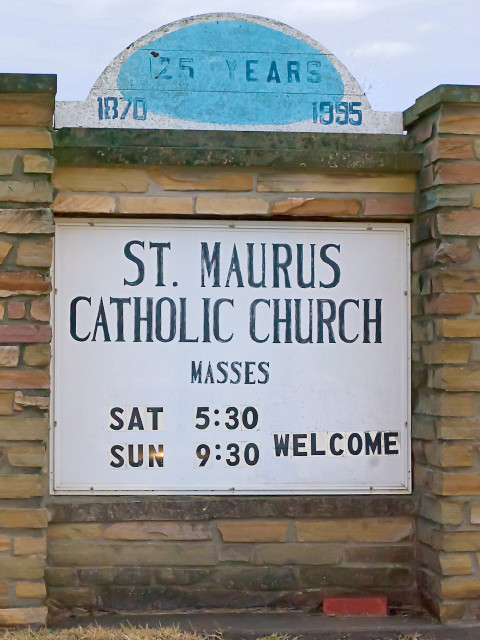
Saint Maurus (a.D. 512-584) was the first oblate of Saint Benedict of Nursia (the founder of Western monasticism). Maurus is said to have founded the first monastery in Gaul and was known for his great holiness of life and as a wonder-worker. His feast day is January 15th, and among other things, is patron against cold and of cobblers.
Address:
10198 Highway B
Perryville, Missouri 63775

A brief history of this church, according to the Mississippi Valley Architecture website:
In the 1850s, a log church was built on land donated by Maurus Biehle, and staffed by C. M. [Congregation of the Mission or Vincentian] fathers. In May, 1869, a new stone church was dedicated for the German Catholic parish, and in January, 1870, Father Joseph Hellwing became the first full time priest. Later addition to the stone church under Father A. M. H. Acker. Still later Father Denner added the fresco, and later yet steam heat was added. In 1925, a tornado took the roof off, and destroyed the windows and temple. When the church was repaired, the old steeple was replaced by a new cupola shaped spire.

Photo taken on December 31st, 2010, during the Octave of Christmas; the church interior has been redecorated in recent years. A closer view of the crèche is here.
According to the 2010 Status Animarum, this parish serves 308 Catholics.
According to one history, Biehle is
...a small village in the southern part of Cinque Hommes [prob. a corruption of Saint-Cosme] Township. A post office was established here in 1876 and named for the Biehle family. Joseph Biehle came from Baden, Germany, in 1839 with the original colony; his son Maurus Biehle came to the store of his uncle Moritz Biehle, and worked there until he purchased a large farm near the present location of Biehle.According to the 2000 federal Census, the village of Biehle has 11 souls.

Festive Christmas decorations. This parish shares its pastor with nearby Saint Joseph in Apple Creek; Mass in Latin is offered here on some Saturdays: check the parish bulletin for details.

Saint Maurus (a.D. 512-584) was the first oblate of Saint Benedict of Nursia (the founder of Western monasticism). Maurus is said to have founded the first monastery in Gaul and was known for his great holiness of life and as a wonder-worker. His feast day is January 15th, and among other things, is patron against cold and of cobblers.
Address:
10198 Highway B
Perryville, Missouri 63775
Chapel at Saint Clement of Rome

Chapel, at Saint Clement of Rome Church, in Des Peres, Missouri.
See also: Photos of Saint Clement of Rome Church, in Des Peres, Missouri.
Friday, January 14, 2011
Ordination of Bishop Rice
CLICK HERE for photos and texts from yesterday's ordination of Bishop Rice at the Cathedral Basilica of Saint Louis.
Thursday, January 13, 2011
Tower Rock
TOWER ROCK is a landmark island in the Mississippi River, in Perry County, Missouri.

The island was first recorded in the journal of Fr. Jacques Marquette, S.J., in 1673. The locals warned him of the dangers of navigating past the island, whose swift waters could easily cause shipwreck. More information is here.
Father Jean-François Buisson de Saint-Cosme, S.J. visited Tower Rock. According to a history written by James M. Gallen:

The island was first recorded in the journal of Fr. Jacques Marquette, S.J., in 1673. The locals warned him of the dangers of navigating past the island, whose swift waters could easily cause shipwreck. More information is here.
Father Jean-François Buisson de Saint-Cosme, S.J. visited Tower Rock. According to a history written by James M. Gallen:
On the feast of the Immaculate Conception, December 8, 1698, St. Cosme said the first mass at what would become the mission of Sainte-Famille. After celebrating mass, St. Cosme and his party left the Tamarois on the afternoon of the eighth. Traveling down river, he mentions landmarks believed to be in Perry County, Missouri. He relates the passage of a rock about one hundred feet high which was said to create dangerous whirlpools during high water. This feature is now known as Tower Rock, and, on occasion, by other names, including Rock of St. Cosme. In keeping with the natives’ custom of offering sacrifice after a successful passage of the rock, St. Cosme and his party ascended the rock and planted "a fine cross on it, chanting the hymn Vexilla Regis, while our people fired three discharges from their guns."
Tuesday, January 11, 2011
A Warning to Schools that are "Catholic In Name Only"
THE MOTLEY MONK discusses a case where the National Labor Relations Board has declared a college "not Catholic", because of a lack of clear hierarchical control and faith formation. It stated that the school is basically secular.
This is not a good precedent, but unfortunately this lack of Catholic identity is our own fault. Please be aware that the principle of "Separation of Church and State" sets up a high wall which is determined solely by the State, and the Church has absolutely no power to determine where the wall is placed. The doctrine also assumes a low-church Protestant ecclesiology.
The time to repudiate the Land O'Lakes Declaration — which led to the secularization of Catholic colleges — is now. Also it is time to start getting on board with Ex corde ecclesiae, a Papal mandate requiring orthodoxy in Catholic theological teaching at universities.
Obviously the State will do whatever it wants, but we mustn't give it any excuses.
This is not a good precedent, but unfortunately this lack of Catholic identity is our own fault. Please be aware that the principle of "Separation of Church and State" sets up a high wall which is determined solely by the State, and the Church has absolutely no power to determine where the wall is placed. The doctrine also assumes a low-church Protestant ecclesiology.
The time to repudiate the Land O'Lakes Declaration — which led to the secularization of Catholic colleges — is now. Also it is time to start getting on board with Ex corde ecclesiae, a Papal mandate requiring orthodoxy in Catholic theological teaching at universities.
Obviously the State will do whatever it wants, but we mustn't give it any excuses.
Sunday, January 09, 2011
Photo of Cardinal Burke
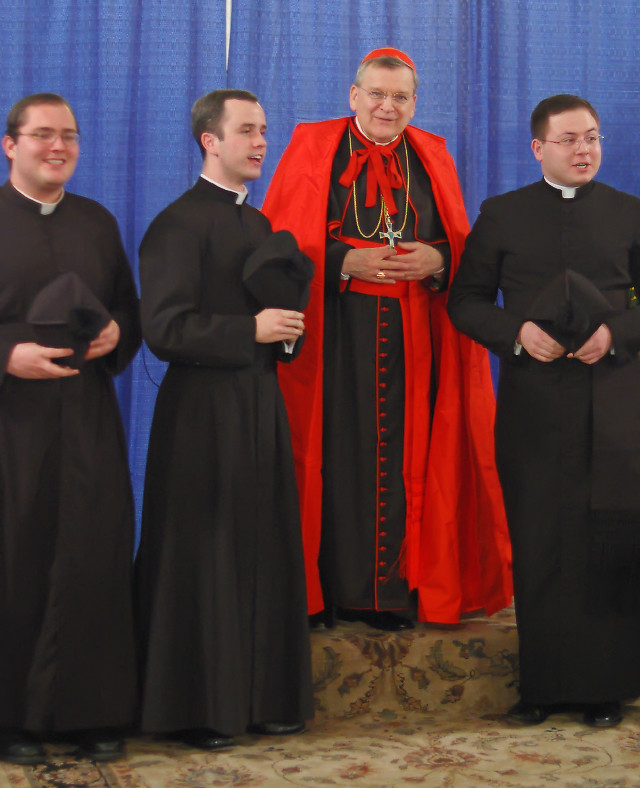
Raymond Leo Cardinal Burke, Prefect of the Supreme Tribunal of the Apostolic Signatura of the Holy Roman Church and Archbishop Emeritus of Saint Louis, poses with seminarians at Saint Francis de Sales Oratory, in Saint Louis. Photo taken last night.
Friday, January 07, 2011
Naturalistic Drawing at Thomas More College
A PRESS RELEASE from Thomas More College:
The Thomas More College of Liberal Arts’ announced today that it is partnering with the renowned Ingbretson Studio to expand the Way of Beauty Program to include a series of weekly classes in the academic method of naturalistic drawing, which has its roots in the baroque and the High Renaissance, including the known methods of Leonardo da Vinci. This is a significant addition to its college courses and summer programs in sacred art.
This new initiative directly challenges modern art theories and seeks to renew in aspiring artists an appreciation for Catholic principles in sacred and secular art.
“Modern art schools teach that art is to be created for art’s sake, and that inspiration is a feeling or emotional reaction,” said David Clayton, artist-in-residence at Thomas More College and Director of the Way of Beauty Program. “What we are teaching aligns fully with the Catholic tradition. Both sacred and secular art should lift our soul to God. It is the good made visible.”
Beautiful art is about conforming to the requirements of another, said Clayton. “Painting within an artistic tradition begins with disciplined imitation that develops humility in the pupil and an openness to external inspiration. Artists must look beyond themselves, and follow in the footsteps of the Great Masters in creating art for a good and noble purpose. This is precisely what we hope to accomplish through our partnership with Paul Ingbretson,” said Clayton.
Students participating in the program will spend one day each week at Ingbretson Studio in Manchester, NH—a fifteen minute drive from Thomas More College’s campus. In addition to the practical method, they will study the philosophy behind academic drawing and painting.
Paul Ingbretson is himself a modern master of the Boston School Tradition, which seeks to combine the truth of impressionist color with good draughtsmanship, sound composition, and skillful paint handling. His studio is known internationally and has trained some of the best known artists painting today, including Catholic portrait painter Henry Wingate, who teaches at the Way of Beauty Atelier summer program.
Ingbretson was taught in Boston in the 1970s by R. Ives Gammell, who is the teacher, writer, and painter who almost single-handedly kept alive the traditional atelier method of painting instruction.
Through Gammel, Ingbretson can trace a line through the Boston School, to the Paris ateliers of the 19th century, and to the 17th century baroque. His students tread a path taken by such masters as the great American artist John Singer Sargent and the Spanish 17th Master, Velazquez.
Clayton noted that the Program’s partnership with Ingbretson Studios helps the College achieve one of the primary objectives of the Way of Beauty Program—to form a new generation of professional artists that produce art that lifts the soul to God.
“For young people who aspire to be an artist, there is no better place to be than Thomas More College,” said Clayton. “It is imperative that aspiring Catholic artists obtain a firm understanding of the Western tradition, which Thomas More College provides through its curriculum. It is further imperative that aspiring Catholic artists receive firm spiritual formation from which they can derive inspiration, which is abundant at this institution.”
“During their four years here,” he added, “students will attend a series of courses in Catholic art and architecture; experience art first-hand during our semester in Rome; produce an icon of their own through our St. Luke Sacred Art Guild, assist me in producing sacred art for our chapel; and further hone their skills through opportunities like the one now available through Ingbretson Studios.”
Thomas More Expands Way of Beauty Program, Adds Naturalistic Drawing
by THOMAS MORE COLLEGE JANUARY 5, 2011
by THOMAS MORE COLLEGE JANUARY 5, 2011
The Thomas More College of Liberal Arts’ announced today that it is partnering with the renowned Ingbretson Studio to expand the Way of Beauty Program to include a series of weekly classes in the academic method of naturalistic drawing, which has its roots in the baroque and the High Renaissance, including the known methods of Leonardo da Vinci. This is a significant addition to its college courses and summer programs in sacred art.
This new initiative directly challenges modern art theories and seeks to renew in aspiring artists an appreciation for Catholic principles in sacred and secular art.
“Modern art schools teach that art is to be created for art’s sake, and that inspiration is a feeling or emotional reaction,” said David Clayton, artist-in-residence at Thomas More College and Director of the Way of Beauty Program. “What we are teaching aligns fully with the Catholic tradition. Both sacred and secular art should lift our soul to God. It is the good made visible.”
Beautiful art is about conforming to the requirements of another, said Clayton. “Painting within an artistic tradition begins with disciplined imitation that develops humility in the pupil and an openness to external inspiration. Artists must look beyond themselves, and follow in the footsteps of the Great Masters in creating art for a good and noble purpose. This is precisely what we hope to accomplish through our partnership with Paul Ingbretson,” said Clayton.
Students participating in the program will spend one day each week at Ingbretson Studio in Manchester, NH—a fifteen minute drive from Thomas More College’s campus. In addition to the practical method, they will study the philosophy behind academic drawing and painting.
Paul Ingbretson is himself a modern master of the Boston School Tradition, which seeks to combine the truth of impressionist color with good draughtsmanship, sound composition, and skillful paint handling. His studio is known internationally and has trained some of the best known artists painting today, including Catholic portrait painter Henry Wingate, who teaches at the Way of Beauty Atelier summer program.
Ingbretson was taught in Boston in the 1970s by R. Ives Gammell, who is the teacher, writer, and painter who almost single-handedly kept alive the traditional atelier method of painting instruction.
Through Gammel, Ingbretson can trace a line through the Boston School, to the Paris ateliers of the 19th century, and to the 17th century baroque. His students tread a path taken by such masters as the great American artist John Singer Sargent and the Spanish 17th Master, Velazquez.
Clayton noted that the Program’s partnership with Ingbretson Studios helps the College achieve one of the primary objectives of the Way of Beauty Program—to form a new generation of professional artists that produce art that lifts the soul to God.
“For young people who aspire to be an artist, there is no better place to be than Thomas More College,” said Clayton. “It is imperative that aspiring Catholic artists obtain a firm understanding of the Western tradition, which Thomas More College provides through its curriculum. It is further imperative that aspiring Catholic artists receive firm spiritual formation from which they can derive inspiration, which is abundant at this institution.”
“During their four years here,” he added, “students will attend a series of courses in Catholic art and architecture; experience art first-hand during our semester in Rome; produce an icon of their own through our St. Luke Sacred Art Guild, assist me in producing sacred art for our chapel; and further hone their skills through opportunities like the one now available through Ingbretson Studios.”
Thomas More College of Liberal Arts
Six Manchester Street
Merrimack, NH 03054
Phone (603) 880-8308, Fax (603) 880-9280
News from the Oratory
 SAINT FRANCIS DE SALES ORATORY EMAIL NEWSLETTER 2653 Ohio Avenue Saint Louis, Missouri 63118 www.institute-christ-king.org www.TraditionForTomorrow.com 314-771-3100 | ||
|
Thursday, January 06, 2011
To Avoid Confusion
WHENEVER I GIVE a lecture, especially if there are older, life-long Saint Louisians present, I offer a bit of family history.
My surname by the way, is pronounced “A-blen” — and so is not spelled as it is pronounced. I am sure that back in the old country it is pronounced differently. The name means “son of Abel” and rumor has it that the first man with that name was a Viking — Abel is not only a Biblical name, but an ancient Germanic name also.
Abeln is hardly a common name, but there are several Abeln families hereabout with that name, and we know of no common ancestors. According to an Abeln genealogy website:
As I mentioned, there are several Abeln families in Saint Louis. I am not from the family in construction, nor from the family from the north side, but rather from the family that had tobacco businesses along South Broadway.
I now include my middle name ‘Scott’, although I never used it until adulthood. If you Google ‘Mark Abeln’, you will find an architect, a real estate appraiser, a large political donor, and a race car driver. I am none of these men, and since I don't want to harm their reputations, I use my middle name. But please call me Mark.
My surname by the way, is pronounced “A-blen” — and so is not spelled as it is pronounced. I am sure that back in the old country it is pronounced differently. The name means “son of Abel” and rumor has it that the first man with that name was a Viking — Abel is not only a Biblical name, but an ancient Germanic name also.
Abeln is hardly a common name, but there are several Abeln families hereabout with that name, and we know of no common ancestors. According to an Abeln genealogy website:
The surname Abeln has his roots in north-west Germany.Abelns today are concentrated in that region of Germany as well as in the nearby regions of the Netherlands. Reading the links, above, I noticed that the Abeln ancestral homeland is quite swampy — and I've always had an affinity for swamps. These Abelns are Catholic, a ‘diaspora’ located in a Protestant region.
In a document from the year 1394 "Abele zu Wieste" is mentioned as "freibauer des Hümmlings".
The first Abeln lived round 1600 in the region Emsland + Cloppenburg round the Hümmling.
The surname Abeln was sometimes changed in Abelen or Abel.
There is no proof that all Abeln have one common ancestor.
As I mentioned, there are several Abeln families in Saint Louis. I am not from the family in construction, nor from the family from the north side, but rather from the family that had tobacco businesses along South Broadway.
I now include my middle name ‘Scott’, although I never used it until adulthood. If you Google ‘Mark Abeln’, you will find an architect, a real estate appraiser, a large political donor, and a race car driver. I am none of these men, and since I don't want to harm their reputations, I use my middle name. But please call me Mark.
In your charity...
Could you please pray for some personal intentions? Thank you.
Gifts of the Magi
THIS EPIPHANY MORNING, I awoke to discover my yard vandalized, or rather, decorated.

These say “Let it snow.” Snow is in fact forecast for today.

29 tubes of candy canes. Anyone have a sweet tooth?
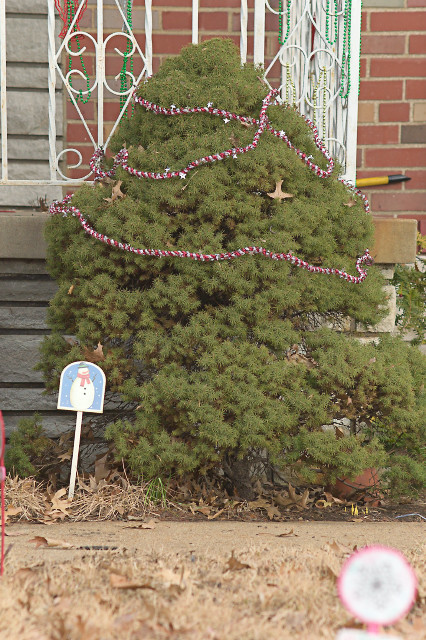
I know the culprits of this deed! What a delightful way to end the season of Christmas!

These say “Let it snow.” Snow is in fact forecast for today.

29 tubes of candy canes. Anyone have a sweet tooth?

I know the culprits of this deed! What a delightful way to end the season of Christmas!
Subscribe to:
Posts (Atom)

